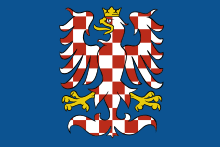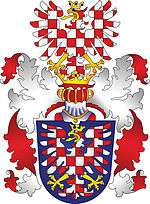Margraviate of Moravia
| Margraviate of Moravia | |||||||||
|---|---|---|---|---|---|---|---|---|---|
| 1182–1918 | |||||||||
.svg.png) Margraviate of Moravia and the Lands of the Bohemian Crown within the Holy Roman Empire (1618) | |||||||||
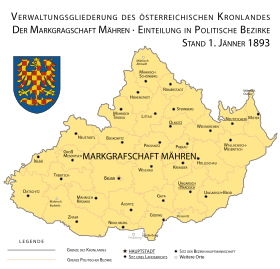 Margraviate of Moravia (1893) | |||||||||
| Status |
Crown land of the Bohemian Crown Crown land of the Habsburg Monarchy (1526–1804), of the Austrian Empire (1804–67), and of the Cisleithanian part of Austria-Hungary (1867–1918) | ||||||||
| Capital |
Olomouc (1182–1641) Brno (1641–1918) | ||||||||
| Common languages |
Moravian dialects of Czech Polish German | ||||||||
| Religion |
Roman Catholic Hussite Lutheran Anabaptist Jewish | ||||||||
| Government | Margraviate | ||||||||
| Margrave | |||||||||
• 1182–1191 (first) | Conrad II of Bohemia | ||||||||
• 1916–1918 (last) | Charles I of Austria | ||||||||
| Legislature | Provincial Diet | ||||||||
| History | |||||||||
• Established | 1182 | ||||||||
• Disestablished | 1918 | ||||||||
| Area | |||||||||
| 1918 | 22,222 km2 (8,580 sq mi) | ||||||||
| Population | |||||||||
• 1918 | 2,662,000 | ||||||||
| |||||||||
The Margraviate of Moravia (Czech: Markrabství moravské; German: Markgrafschaft Mähren) or March of Moravia was a marcher state existing from 1182 to 1918 and one of the lands of the Bohemian Crown. It was officially administrated by a margrave in cooperation with a provincial diet. It was variously a de facto independent state, and also subject to the Duchy, later the Kingdom of Bohemia. It comprised the region called Moravia within the modern Czech Republic.
Geography
The Margraviate lay east of Bohemia proper, with an area about half that region’s size. In the north, the Sudeten Mountains, which extend to the Moravian Gate, formed the border with the Polish Duchy of Silesia, incorporated as a Bohemian crown land upon the 1335 Treaty of Trentschin. In the east and southeast, the western Carpathian Mountains separated it from present-day Slovakia. In the south, the winding Thaya River marked the border with the Duchy of Austria.
Moravians, usually considered a Czech people that speak Moravian dialects, made up the main part of the population. According to a 1910 Cisleithanian census, 27.6% identified themselves as German Moravians.[1] These ethnic Germans would later be expelled after the Second World War. Other ethnic minority groups included Poles, Roma and Slovaks.
History
After the early medieval Great Moravian realm had been finally defeated by the Árpád princes of Hungary in 907, what is now Slovakia was incorporated as "Upper Hungary" (Felső-Magyarország), while adjacent Moravia passed under the authority of the Duchy of Bohemia. King Otto I of Germany officially granted it to Duke Boleslaus I in turn for his support against the Hungarian forces in the 955 Battle of Lechfeld. Temporarily ruled by King Bolesław I Chrobry of Poland from 999 until 1019, Moravia was re-conquered by Duke Oldřich of Bohemia and ultimately became a land of the Crown of Saint Wenceslas held by the Přemyslid dynasty.[1]
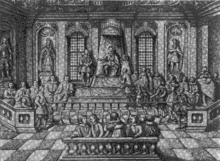
In 1182, the Margraviate was created at the behest of Emperor Frederick Barbarossa by merger of the three Přemyslid appanage principalities of Brno, Olomouc and Znojmo, and given to Conrad II, the son of Prince Conrad of Znojmo. As heir apparent, the future King Ottokar II of Bohemia was appointed Moravian margave by his father Wenceslaus I in 1247. Along with Bohemia, Moravia was ruled by the House of Luxembourg from the extinction of the Přemyslid dynasty until 1437. Jobst, nephew of Emperor Charles IV inherited the Margraviate in 1375, ruled autonomously and was even elected King of the Romans in 1410. Shaken by the Hussite Wars, the Moravian nobles remained loyal supporters of the Luxembourg emperor Sigismund.[1]
In 1469, Moravia was occupied by the Hungarian king Matthias Corvinus, who had allied with the Catholic nobility against the rule of George of Poděbrady and had himself elected rival king of Bohemia at Olomouc. The rivalry with King Vladislaus II was settled in the 1479 Peace of Olomouc, whereby Matthias renounced the royal title but retained the rule over the Moravian lands.[2]
With the other lands of the Bohemian Crown, the Margraviate was incorporated into the Habsburg Monarchy upon the death of King Louis II in the 1526 Battle of Mohács. Moravia was ruled as a crown land within the Austrian Empire from 1804 and within Cisleithanian Austria from 1867.[3]
During the foundation of Czechoslovakia after World War I, the Margraviate was transformed into “Moravia Land”, later “Moravia-Silesia Land” in 1918. This autonomy was eliminated in 1949 by the communist government and has not been re-established since.[1]
Government
_(02).jpg)
The Margrave held ultimate authority in Moravia, throughout the history of the Margraviate. This meant that as its Margraves became more foreign, so too did governance of the Margraviate.
Moravia possessed a legislature, known as the Moravian Diet. The assembly has its origins in 1288, with the Colloquium generale, or curia generalis.[4] This was a meeting of the upper nobility, knights, the Bishop of Olomouc, abbots and ambassadors from royal cities. These meetings gradually evolved into the diet.
The power of this diet waxed and waned throughout history. By the end of the Margraviate, the diet was almost powerless. The diet consisted of three estates of the realm: the estate of upper nobility, the estate of the lower nobility, and the estate of prelates and burghers.[5] With the February Patent of 1861, the diet was reformed into a more egalitarian body. It still retained the same structure, but the members changed. It consisted of assembly seats for landowners, city-dwellers, and rural farmers. This was retained until the diet was abolished after the fall of the Dual Monarchy.[5]
Moravian eagle
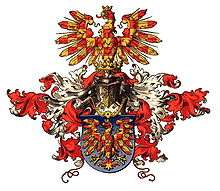
The coat of arms of Moravia is charged with a crowned silver-red chequered eagle with golden claws and tongue. It first appeared in the seal of Margrave Přemysl (1209-1239), a younger son of King Ottokar I of Bohemia. After 1462 is Moravian eagle gold-red chequered,[2] but never accepted by moravian assembly.
Administration
Until 1848
In the mid 14th century Emperor Charles IV, also King of Bohemia and Margrave of Moravia, established administrative divisions called kraje. These subdivisions were named for their capitals, some of which were:
After 1848
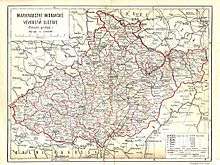
After the 1848 revolutions, the kraje were replaced by political districts (politický okres), which were largely retained by the Czechoslovak administration after 1918:
- Boskovice
- Brno
- Dačice
- Hodonín
- Holešov
- Hranice na Moravě
- Hustopeče
- Jihlava
- Kroměříž
- Kyjov
- Litovel
- Mikulov
- Místek
- Moravská Třebová
- Moravské Budějovice
- Moravský Beroun
- Moravský Krumlov
- Nové Město na Moravě
- Nový Jičín
- Olomouc
- Ostrava
- Přerov
- Prostějov
- Rýmařov
- Šternberk
- Šumperk
- Tišnov
- Třebíč
- Uherské Hradiště
- Uherský Brod
- Valašské Meziříčí
- Velké Meziříčí
- Vsetín
- Vyškov
- Zábřeh
- Znojmo
Rulers of Moravia
- Part of Great Moravia (c.820-907)
Dukes of Moravia
Přemyslid dynasty
| Ruler | Born | Reign | Death | Ruling part | Consort | Notes | |
|---|---|---|---|---|---|---|---|
| Bretislaus I |  | 1002/5 | 1019/29-1033 | 10 January 1055 | Moravia | Judith of Schweinfurt 1020 four children | Son of Ulrich of Bohemia. First separation of Moravia from Bohemia. His father usurped his place for a year. |
| Ulrich I |  | 975 | 1033-1034 | 9 November 1034 | Moravia | Unknown no children Božena c.1002 (morganatic) one child | After his death, his son was replaced in Moravia. |
| Bretislaus I |  | 1002/5 | 1034-1055 | 10 January 1055 | Moravia | Judith of Schweinfurt 1020 four children | Recovered his throne. After his death his sons shared the inheritance. |
| Conrad I |  | c.1035 | 1055-1056 | 6 September 1092 | Brno | Wirpirk of Tengling 1054 two children | Received Brno after the partition of 1055. In the next year his brother Spytihněv ascended to Bohemia and reunited it with all Moravian lands. |
| Vratislaus I |  | c.1035 | 1055-1056 | 14 January 1092 | Olomouc | Maria before 1057 no children Adelaide of Hungary I 1057 four children Świętosława of Poland 1062 five children | Received Olomouc after the partition of 1055. In the next year his brother Spytihněv ascended to Bohemia and reunited it with all Moravian lands. |
| Otto I the Fair |  | 1045 | 1055-1056 | 9 June 1087 | Znojmo | Euphemia of Hungary before 1073 two children | Received Znojmo after the partition of 1055. In the next year his brother Spytihněv ascended to Bohemia and reunited it with all Moravian lands. |
| Spytihněv I |  | 1031 | 1056-1061 | 28 January 1061 | Moravia | Ida of Wettin c.1054 one child | United Bohemian and Moravian lands. |
| Conrad I |  | c.1035 | 1061-1092 | 6 September 1092 | Brno and Znojmo | Wirpirk of Tengling 1054 two children | Received Brno and Znojmo. In 1092 divided the land between his two sons. |
| Otto I the Fair |  | 1045 | 1061-1087 | 9 June 1087 | Olomouc | Euphemia of Hungary before 1073 two children | Received Olomouc after the partition of 1061. |
| Boleslaus | 1062 | 1087-1091 | 11 August 1091 | Olomouc | Unmarried | Received Olomouc after the partition of 1061. | |
| Svatopluk I the Lion |  | 1075 | 1091-1109 | 21 September 1109 | Olomouc | Unknown one child | |
| Leopold I | ? | 1092-1112 | 15 March 1112 | Znojmo | Ida of Austria one child | Son of Conrad I. Received Znojmo after the partition of 1092. Left no descendants, and his lands was reunited with Brno | |
| Ulrich II | 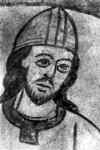 |
c.1035 | 1092-1112 | 5 January 1113 | Brno | Adelaide two children | Son of Conrad I. Received Brno after the partition of 1092. In 1112 reunited Brno and Znojmo. |
| 1112-1113 | Brno and Znojmo | Sophia of Berg 1113 three children | |||||
| Sobeslaus I | 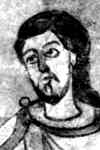 | c.1075 | 1113-1123 | 14 February 1140 | Brno and Znojmo | Adelaide of Hungary II 1123 five children | Son of Vratislaus I. |
| Conrad II | 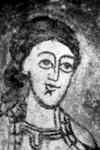 | c.1075 | 1123-1161 | 14 February 1140 | Znojmo | Maria of Serbia 1132 four children | Son of Vratislaus I. |
| Otto II the Black | 1085 | 1109-1123 | 18 February 1126 | Olomouc | Unknown one child |
Ruled in Olomouc, since 1091 with his brother Svatopluk. Acquired Brno in 1123. | |
| 1123-1126 | Olomouc and Brno | ||||||
| Wenceslaus Henry | 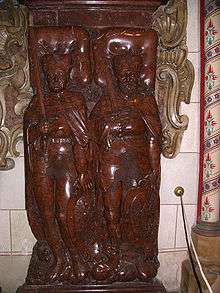 | 1107 | 1126-1130 | 1 March 1130 | Olomouc | Unmarried | |
| Vratislaus II | c.1111 | 1126-1146 | 1146 | Brno | A Russian princess 1132 three children | ||
| Leopold II | 1102 | 1130-1137 | 1143 | Olomouc | Unmarried | Son of Bořivoj II, Duke of Bohemia. | |
| Vladislaus | ? | 1137-1140 | 1165 | Olomouc | Unmarried | Son of Sobeslaus I. | |
| Otto III | 1122 | 1140-1160 | 12 May 1160 | Olomouc | Durancia five children | Son of Otto II. | |
| Spytihněv II | ? | 1146?-1182 | 1199 | Brno | Umarried | In 1182 abdicated for Conrad III. | |
| Frederick I | 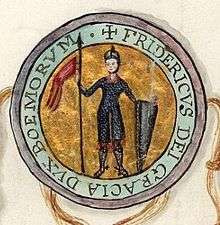 | 1142 | 1160-1173 | 25 March 1189 | Olomouc | Elizabeth of Hungary 1157 six children | Son of Vladislaus II, Duke of Bohemia. |
| Ulrich III | 1134 | 1173-1177 | 18 October 1177 | Olomouc | Cecilia of Thuringia no children Sophia of Meissen no children | Son of Vladislaus II, Duke of Bohemia. | |
| Wenceslaus | 1137 | 1177-1178 | after 1192 | Olomouc | Unmarried | Son of Sobeslaus I. Abdicated for Conrad III. | |
| Conrad III Otto | 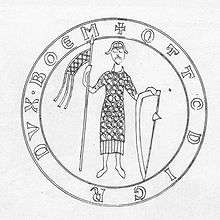 |
c.1136 | 1161-1178 | 9 September 1191 | Znojmo | Hellicha of Wittelsbach before 1176 no children |
Son of Conrad II. United Znojmo and Olomouc. Brno joined in 1182, when he also became the first Margrave of Moravia. |
| 1178-1182 | Znojmo and Olomouc | ||||||
| 1182-1191 | Moravia | ||||||
Margraves of Moravia
Přemyslid dynasty
- Conrad II Otto 1182-1191
united with Bohemia 1189-1197
- Vladislaus I Henry 1197-1222, second son of King Vladislaus II of Bohemia and Judith of Thuringia
- Vladislaus II 1223-1227, son of King Ottokar I of Bohemia and Constance of Hungary
- Přemysl 1227-1239, son of King Ottokar I of Bohemia and Constance of Hungary
- Vladislaus III 1239-1247, son of King Wenceslaus I of Bohemia and Kunigunde of Hohenstaufen
- Ottokar II 1247-1278, son of King Wenceslaus I of Bohemia and Kunigunde of Hohenstaufen
directly held by King Rudolph I of Germany 1278-1283
- Wenceslaus II 1283-1305, son of King Ottokar II of Bohemia and Kunigunda of Halych
- Wenceslaus III 1305-1306, son of King Wenceslaus II of Bohemia and Judith of Habsburg
Various dynasties
- Rudolf I of Habsburg 1306-1307, son of King Albert I of Germany and Elizabeth of Carinthia
- Henry of Carinthia 1307-1310, son of Duke Meinhard of Carinthia and Elisabeth of Bavaria
Luxembourgs
- John 1310-1333, son of Emperor Henry VII and Margaret of Brabant
- Charles IV 1333-1349, son of King John of Bohemia and Elizabeth
- John Henry 1349-1375, enfeoffed by his brother King Charles IV
- Jobst of Moravia 1375-1411, son of John Henry, with his brothers John Sobieslaus (until 1394) and Prokop (until 1405)
- Sigismund 1419-1423, son of Emperor Charles IV and Elizabeth of Pomerania
Various dynasties
- Albert V of Austria 1423-1439, son-in-law of Sigismund
- Ladislaus the Posthumous 1440-1457, son of Albert and grandson of Sigismund
- George of Poděbrady 1458-1468
- Matthias Corvinus 1468-1490, second son of John Hunyadi und Erzsébet Szilágyi
Jagiellons
- Vladislaus II 1490-1516, son of King Casimir IV Jagiellon of Poland and Elisabeth of Habsburg
- Louis II 1516-1526, son of King Vladislaus II
Habsburgs
- Ferdinand I 1527-1564, fourth child of Philip I and Joanna of Castile
- Maximilian II 1564-1576, son of Emperor Ferdinand I and Anne of Bohemia and Hungary
- Rudolf II 1576-1608, son of Emperor Maximilian II
- Matthias II 1608-1617, son of Emperor Maximilian II
Under the united rule of the Bohemian kings from 1611 (see List of rulers of Bohemia).
References
- 1 2 3 4 Pánek, Jaroslav; Tůma, Oldřich (2009). A History of the Czech Lands. Prague: Charles University Press. ISBN 978-80-246-1645-2.
- 1 2 Prinz, Friedrich (1993). Deutsche Geschichte in Osten Europas: Böhmen und Mähren. Berlin: Wolf Jobst Siedler Verlag GmbH. p. 381. ISBN 3-88680-200-0. Retrieved 25 February 2013.
- ↑ Urban, Otto (1998). "V.". Czech Society 1848–1918. United Kingdom: Cambridge University Press. ISBN 0-521-43155-7. Retrieved 25 February 2013.
- ↑ Válka, Josef (1995). Dějiny Moravy: Morava reformace, renesance a baroka (in Czech). Brno: Muzejní a vlastivědná společnost v Brně. ISBN 9788085048629. Retrieved 7 March 2013.
- 1 2 David, Jiří (2009). "Moravian estatism and provincial councils in the second half of the 17th century". Folia historica Bohemica. 1. 24: 111–165. ISSN 0231-7494.
